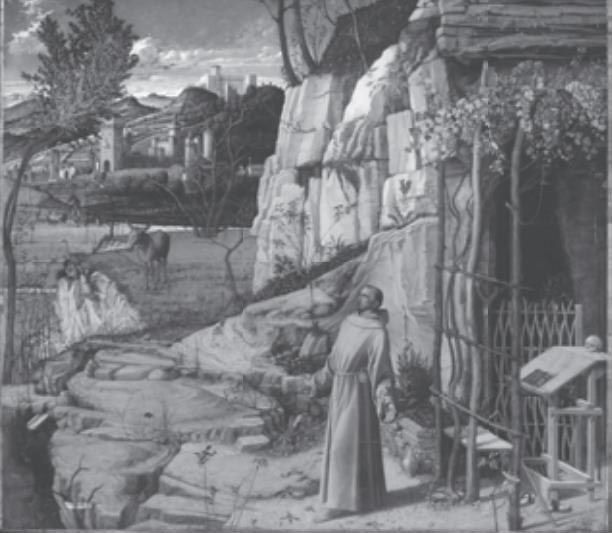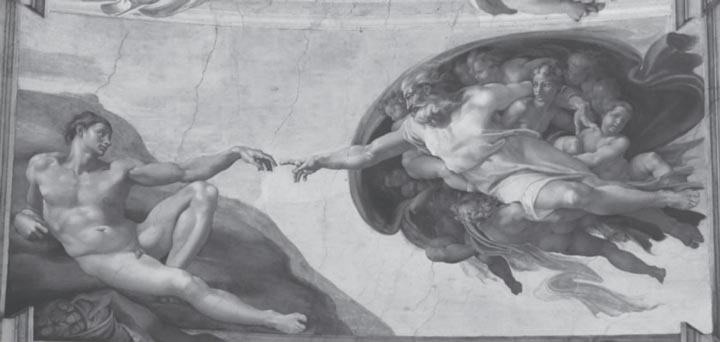





Renaissance started in Italy beginning in the late 13th century. The city that is renowned as the birthplace of the Renaissance and in particular, Renaissance painting, is Florence. Florence was a major financial center and was dominated by the Medici family for around sixty years, who became patrons of art. On the one hand, almost all of the art of the period has a religious theme with scenes from the bible taking prominence. On the other hand, the period saw the increasing importance of humanism and made biblical stories closer to life. As art became more associated with daily lives, painters began to look for ways to make their work more realistic, such as accentuating the contrast between light and darkness, liner perspective, anatomy, etc. The eulogy to human beings and the belief in sciences became the dominant principle in painting.
文艺复兴13世纪末期在意大利开始,其起始城市,尤其是文艺复兴绘画的起始城市,是佛罗伦萨。佛罗伦萨是当时欧洲主要的财政中心,由富有的美第奇家族统治长达60年,这个家族也就成为支持艺术的最大“金主”。一方面,文艺复兴时期的绘画题材大多来自圣经;另一方面,这一时期人文主义开始盛行,圣经故事也变得人性化了。随着艺术越来越贴近生活,画家们开始寻找让自己的作品变得更真实的方法,如光与影的对比、透视法、解剖学等等。这一时期,对人本身的歌颂和对科学的信仰成为指导绘画的主要思想。

马萨乔的《圣母子》

The Renaissance painting has the following features:
First, the Renaissance painting saw a return to classics and a switch to humanism. A number of Classical texts, that had been lost to Western European scholars for centuries, became available. These included Philosophy, Poetry, Drama, Science, a thesis on the Arts and Early Christian Theology from the ancient Greek and Roman civilization. These texts, in contrast to the church-oriented ideology in the Medieval, showed high interest in Humanist philosophy and championed the ability of human beings. It meant that man's relationship with humanity, the universe and with God was no longer the exclusive province of the Church. A revived interest in the Classics inspired a corresponding classicism in painting, which manifested itself as early as the 1420s in the paintings of Masaccio, who painted The Virgin and the Child like ordinary human beings.
Portraiture was uncommon in the 14th and early 15th century. During the 15th century portraiture became common, initially often formalised profile portraits but increasingly three-quarter face, bust-length portraits. The emphasis on presenting life-like portraits which also implied the personality and psychology or of the subject was another aspect of humanism. Portraiture was to become a major subject for High Renaissance painters such as Raphael and Titian. Raphael's Medici shows a conceited duke wearing opulent costumes and holding a mini statue of a woman who was possibly his future wife. The painting is renowned for its bold use of color and the accurate representation of the garment's texture.
With the growth of Humanism, artists turned to Classical themes, particularly to fulfill commissions for the decoration of the homes of wealthy patrons, the best known being Botticelli's The Birth of Venus for the Medici.The painting shows Venus emerging from the Aegean to be greeted by the gods of wind and the gods of flower. The statue of the subjects and the clothes' folds are vividly presented. Venus, shyly looking at the world in melancholy, seems to be uncertain about her future. Increasingly, Classical themes were also seen as providing suitable allegorical material for civic commissions.

拉斐尔的《美第奇公爵》

Second, Bible stories were another major theme of the Renaissance painting. Much painting of the Renaissance period was commissioned by or for the Catholic Church. These works were often of large scale and were frequently cycles painted in fresco of the life of christ, the life of the virgin or the life of a saint. There were also many allegorical paintings on the theme of Salvation and the role of the Church in attaining it. Churches also commissioned altarpieces which were painted in tempera on panel and later in oil on canvas. Humanism also influenced the manner in which religious themes were depicted, notably on Michelangelo's Ceiling of the Sistine Chapel: The Genesis . The spectacular painting records nine stories from the Old Testament, of which God creating Adam is the most famous. Adam, who has just been created and has no soul yet, lies on the ground with soft limbs and dull eyes. God, clustered by angles, reaches out his hand to him. Instead of painting God breathing soul into his child, Michelangelo made their fingers touch to achieve that aim.

《狂喜中的圣弗朗西斯》

Third, the Renaissance artists developed realistic painting techniques. Bru nelleschi developed liner perspective and executed by artists such as Masaccio and Uccello. In Uccello's
fresco
 The Presentation ofthe Virgin
, the townscape gives an impression of depth. The depiction of landscape was encouraged by thedevelopment of linear perspective and the inclusion ofdetailed landscapes in the background. Giovanni Bellini has created a detailed la ndscape with a pastoralscene between the foreground and background mountains in his
St. Francis in Ecstasy
.The artists also studied light and shadow in the search for realism in their work.Taddeo Gaddi's
Annunciation
The Presentation ofthe Virgin
, the townscape gives an impression of depth. The depiction of landscape was encouraged by thedevelopment of linear perspective and the inclusion ofdetailed landscapes in the background. Giovanni Bellini has created a detailed la ndscape with a pastoralscene between the foreground and background mountains in his
St. Francis in Ecstasy
.The artists also studied light and shadow in the search for realism in their work.Taddeo Gaddi's
Annunciation
 to
the Shepherds
is the first known large painting of a night scene. The internal light source of the picture is the angel. The knowledge of anatomy was advanced by Leonardo da Vinci's meticulous
dissection
to
the Shepherds
is the first known large painting of a night scene. The internal light source of the picture is the angel. The knowledge of anatomy was advanced by Leonardo da Vinci's meticulous
dissection
 of 30 corpses. He impressed upon students the necessity of the close observation of life and made the drawing of live models an essential part of a student's formal study of the art of painting. Leonardo's picture of
St. Jerome in the Wilderness
shows the results of detailed study of the shoulder girdle, known from a page of drawings.
of 30 corpses. He impressed upon students the necessity of the close observation of life and made the drawing of live models an essential part of a student's formal study of the art of painting. Leonardo's picture of
St. Jerome in the Wilderness
shows the results of detailed study of the shoulder girdle, known from a page of drawings.
文艺复兴时期的绘画主要有以下特点:
第一,古典主义的回归和人文主义的兴盛。很多遗忘多年的古典主义文本此时被学者们重新发掘出来,包括古希腊和古罗马的哲学、诗学、戏剧、科学、艺术理论和早期基督教神学的作品。与中世纪一切都围着教堂转的文化不同,这些古典文本对人本身很感兴趣,热烈歌颂人自身的能力,这就意味着人与人性、宇宙和上帝不需要通过教堂才能沟通。古典主义的回归也表现在画作上,如15世纪20年代马萨乔的作品《圣母子》,圣母和圣子的形象都很接近普通人。
肖像画在14世纪和15世纪早期还很少见,到了15世纪中后期,肖像画开始流行。开始的肖像画只是很刻板的侧面像,后来发展到画出3/4的面部,再后来一直画到胸部。人物画栩栩如生,并且力求表现人物的个性和思想状态,是人文主义的又一体现。肖像画是文艺复兴鼎盛时期的代表人物拉斐尔和提香常用的形式。拉斐尔的《美第奇公爵》表现了一个狂妄的美第奇骄傲光鲜地站在绿色的背景前,右手中握着一个可能是他将来妻子的缩小模型。作品中活泼和大胆的颜色,以及艺术家对于公爵服装丰富的质感的把握,共同构成作品的不朽。
人文主义的兴盛与古典主义的回归相辅相成,古典主义神话绘画成为艺术家的“金主”们装饰豪宅的主要艺术品。最著名的是波提切利为美第奇家族画的《维纳斯的诞生》,此画表现女神维纳斯从爱琴海中浮水而出,风神、花神迎送于左右的情景。画面上人物的体态和衣纹表现十分出色,维纳斯是那样无动于衷地以羞怯和幽怨的感情在对待一切,她对于生活的未来不是充满乐观的信心,而是感到惆怅和迷惑。逐渐地,古典主义神话和寓言也成为民间作画的常用题材。

达·芬奇的《在旷野的圣杰罗姆》
第二,圣经故事是文艺复兴时期绘画的另一个主要题材。这一时期的许多绘画都是天主教教堂赞助的,这些画作规模宏大,常以壁画的形式创作,内容主要是基督、圣母玛丽亚或是圣徒的生活,也有许多画作表现救赎,以及教堂在救赎过程中必不可少的作用。教堂还赞助创作了许多神坛上的彩蛋装饰画和油画。人文主义也影响到了宗教画的创作,最有名的是米开朗基罗的西斯廷教堂穹顶《创世纪》。此幅穹顶画描绘了旧约中创世纪的九个场景,其场面宏大,气势恢弘,人物众多。《创世纪》中以上帝创造亚当最为著名,亚当赤身裸体地躺在地上,四肢松软,眼神无光,这时他还没有灵魂。此刻,上帝像一个白发长须的智慧老人,在天使簇拥下向他伸出手来。米开朗基罗将上帝往亚当口中吹气的情节改成上帝伸出手指与亚当的手指相碰,从而赋予他灵魂。

西斯廷教堂壁画《上帝创造亚当》
第三,文艺复兴时期的画家发展了写实绘画技巧。布鲁内莱斯基发明了透视法,后来的艺术家如马萨乔和乌切洛把透视法运用到他们的创作中。在乌切洛的《引见圣女》中,人物环境表现出一定的景深。透视法加速了风景元素的发展,画作中常以细致的风景作为背景。乔瓦尼·贝里尼在他的作品《狂喜中的圣弗朗西斯》中,在前景和背景中的群山之间加入了描摹细致的田园风景。艺术家们还研究光与影的现象使作品更加立体。特达·高迪的《天使报喜》是迄今为止所知的第一个在画内运用光线的作品,这里的光源是给约瑟夫报喜的天使。达·芬奇发展了解剖学在绘画中的运用,他为此细致地解剖了30多具尸体。他向学生证明了细致入微地观察生活和画模特的重要性,直到今天模特画仍是美术学生不可缺少的一门课。达·芬奇的《在旷野的圣杰罗姆》为了展现了对肩胛骨的细致描述,为此这幅画画了一整页的肩胛骨草图。
The Renaissance artists all started out as apprentices. There was no art institute back then. Anyone who wanted to become an artist had to apprentice for workshop owners in childhood. These children worked not only as assistants for their masters, but babysitters and servants at the same time. Many of them ended up nameless even though their skills had far surpassed their mentors. Such workshop, like any other workshop for hair-dressing or shoe-making, was a commercial entity that attached great importance on profits. As a result, the status of the Renaissance artists was no higher than ordinary tradesmen who gave priority to money-making. In this sense, they should not be over-evaluated. The success of an artist was impossible if he had no powerful patron to support him, such as the pope or the court, the Medici Family in Florence being a case in point.

乔托

文艺复兴时期的艺术家无一例外地经历了学徒和帮工时期。文艺复兴时期没有现在的艺术学院,所以一个人如果想在雕塑或者绘画上有所发展,必须先进入某一个师傅的作坊。那些孩子到了作坊以后被当做童工,而这些童工都很艰辛,除了为师傅做助手之外还要帮师傅看孩子、煮饭等。然而,有很多孩子到最后还是默默无闻,即使他们的功力已经远远超过师傅了。在那个时代,这些作坊的地位并不很高,它们与从事剃头、制鞋的作坊是一样的,纯粹是一个订购、制作产品和赚钱的地方。因此,文艺复兴时期的艺术家也只是像一般的工匠一样地生存,想着怎样赚大钱、做买卖,不能把他们看得太神圣了。当时的艺术家要成功,背后必须要有一个很强有力的庇护人,比如教皇、教廷,或者像佛罗伦萨的美第奇家族这样的大家族。

《犹大之吻》

Italian Renaissance Art began with Giotto (1267-1337) who is considered to be the first painter to have broken with the tradition of Byzantine art at the end of the middle ages. Giotto made advances in representing the human body in a more realistic way.
Giotto did not base the figures that he painted upon any painterly tradition, but upon the observation of life. Unlike those of his Byzantine contemporaries, Giotto's figu res are solidly three-dimensional;they stand squarely on the ground, have discernible anatomy and are clothed in garments with weight and structure. But more than anything, what set Giotto's figures apart from those of his contemporaries are their emotions. In the faces of Giotto's figures are joy, rage, despair, shame, spite and love. The cycle of frescoes of the Life of Christ and the Life of the Virgin that he painted in the Scrovegni Chapel in Padua set a new standard for narrative pictures. Kiss of Judas , the crowd which is searching for Jesus wears exciting expression while Jesus remains calm as Judas kisses him as a code for his identification. In his Lamentation which depicts the remorse of Jesus' mother and his disciples, the sadness on peoples' faces are aptly presented.
意大利文艺复兴开始于乔托(1267~1337年),他打破了中世纪末拜占庭艺术描绘人体的条条框框,把人体画得更加写实。
乔托没有将他的画建立在前人定下的传统基础上,而是通过自己的观察来创作。与拜占庭的同行不同,乔托的人物画都是三维立体的,他们挺立在地面上,身体形态突出,衣服有重量有结构。最重要的是,乔托笔下的人物有感情,他们的脸上表现出欢喜、愤怒、失望、羞愧、怨怼或者是爱。在帕多瓦的斯科洛文尼教堂,保存着乔托描绘基督生活和圣母生活的壁画,它们为叙述性画风树立了新的榜样。他的圣经题材作品,《犹大之吻》描绘了背叛基督的犹大以亲吻为暗号,向抓捕基督的人暗示他亲吻的那个人就是基督。画中人物表情激动,也画出了基督泰然自若的神情。在他的《哀悼耶稣》中,描绘了耶稣死后他的母亲和门徒围在身边哀悼的情景,人们哀伤的表情栩栩如生。

马萨乔的《纳税银》

Masaccio (1401—1428) was the leading figure in the Early Renaissance painting. More than any other artist, he recognized the implications in the work of Giotto. He carried forward the practice of painting from nature. His paintings demonstrate an understanding of anatomy, of foreshortening, of linear perspective, of light and the study of drapery. Among his works, the figures of Adam and Eve being expelled from Eden, painted on the side of the arch into the chapel, are renowned for their realistic depiction of the human form and of human emotion. In The Tribute Money, Masaccio put three scenes of a story into one picture and St. Peter appears three times in the fresco: the middle one is taking advice from Jesus of how to obtain the money, the left one is scooping money out of the river, and the right one handing the money to the collector. The robes the people are wearing are vivid in texture, color and weight.
意大利画家马萨乔(1401~1428年)是乔托的忠实追随者,并把他的风格发扬光大。他的画表现出对解剖学的研究,按照透视法缩短前景,流线感强,光影调和,布料的质地和褶皱清晰。他画在教堂拱门一边的《逐出伊甸园》因真实展现人体和人物情绪而出名;他的壁画《纳税银》中把一个故事的三个场景放到了一起,出现了三个圣彼得:中间的圣彼得在听基督教导如何得到钱,左边的一个从河里把钱捞上来,右边的一个把钱交给税官。画中人物身上的长袍颜色鲜艳、质地分明、有垂坠感。
Leonardo da Vinci (1452–1519)was one of the three leading figures in High Renaissance. The other two were Raphael and Michelangelo. He was an astonishing virtuoso. His work encompassed painting, mathematics, sculpture, music, biology, medicine, philosophy, etc. People today can only marvel at the numerous ideas running in the giant's head through his huge volumes of notebooks.
One of Leonardo Da Vinci's most famous drawings is The Vitruvian Man, the figure of a naked man placed within a circle and a square. The arms and legs are shown in two positions superimposed on one another. It was made as a study of the proportions of the human body.
1502 Leonardo painted the wife of a Florentine official, the Mona Lisa, destined to become the most famous image in art. The ambiguity of the subject's expression, frequently described as enigmatic, the monumentality of the composition, the subtle modeling of forms and the atmospheric illusionism were novel qualities that have contributed to the continuing fascination and study of the work. More than any other artist, he advanced the study of "atmosphere". In his paintings such as the Mona Lisa and Virgin of the Rocks , he used light and shade with such subtlety that, for want of a better word, it became known as Leonardo's "sfumato" or "smoke".
Simultaneous to inviting the viewer into a mysterious world of shifting shadows, chaotic mountains and whirling torrents, Leonardo achieved a degree of realism in the expression of human emotion, as evidenced by Leonardo's Last Supper. In the painting, after declaring that "One of you is going to betray me", Jesus remains calm while his disciples take on different expressions, some irritated, some agitated, some frustrated, and Judas, the traitor, clutching his purse in fear. It became the benchmark for religious narrative painting for the next half millennium.

《蒙娜丽莎》

列奥纳多·达·芬奇(1452~1519年)与拉斐尔和米开朗基罗并称意大利“文艺复兴三杰”。他是一个世上少有的全才,研究的领域涉及绘画、数学、雕塑、音乐、生物学、医学、哲学等等。他用来记录各种想法的笔记本一直流传到今天,让世人惊叹不已。
达·芬奇最有名的画作之一是《维特鲁人》,一个框在圆形和长方形里的裸体男子,他的手脚分别伸展开放在两个不同的位置,相互叠加。这是用来研究人体比例的一幅画。
1502年,达·芬奇为一位佛罗伦萨官员的妻子蒙娜丽莎画了一幅肖像,这幅画成为千古名作。画中人物的表情难以捉摸,画的尺寸特别大,有种神秘莫测的气氛。达·芬奇深入了对“氛围”的研究,在《蒙娜丽莎》和《岩间圣母》等作品中他都巧妙地使用了光影的对比,形成了无法用言语描述的“氛围”,这成为他独树一帜的风格。
在邀请人们体验光影玄幻、自然奇妙时,达·芬奇也不乏展现人物内心活动的现实主义作品。在他最负盛名的画作《最后的晚餐中》,当基督宣布“你们当中有人要出卖我”时,人物各自截然不同的情绪表现得酣畅淋漓:基督镇定自如,他的门徒有的愤怒,有的激动,有的沮丧,而叛徒犹大则仅仅地捂紧了钱袋惊恐地看着基督。这幅画成为了以后几百年叙述性画作的基石。

人物情绪各异的《最后的晚餐》
